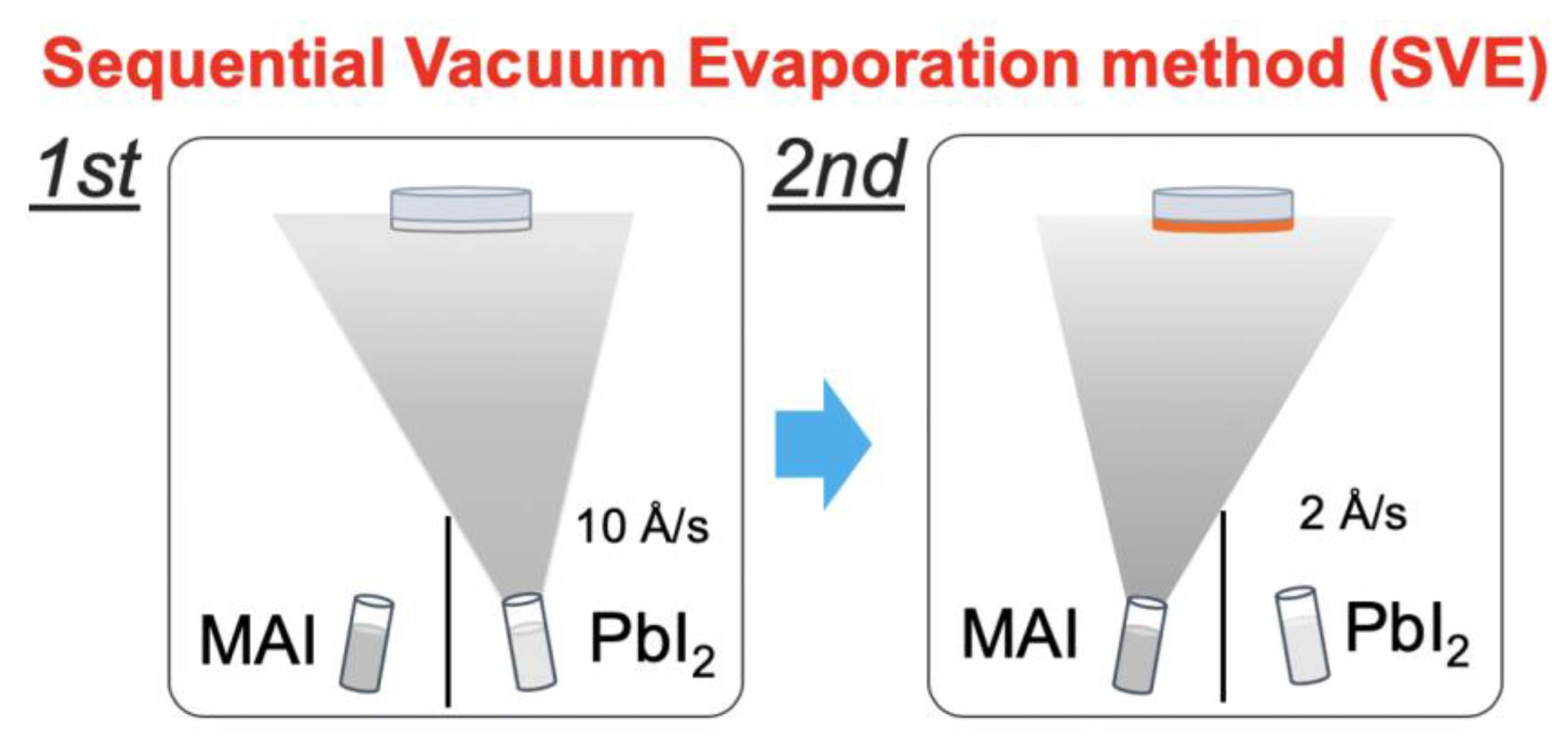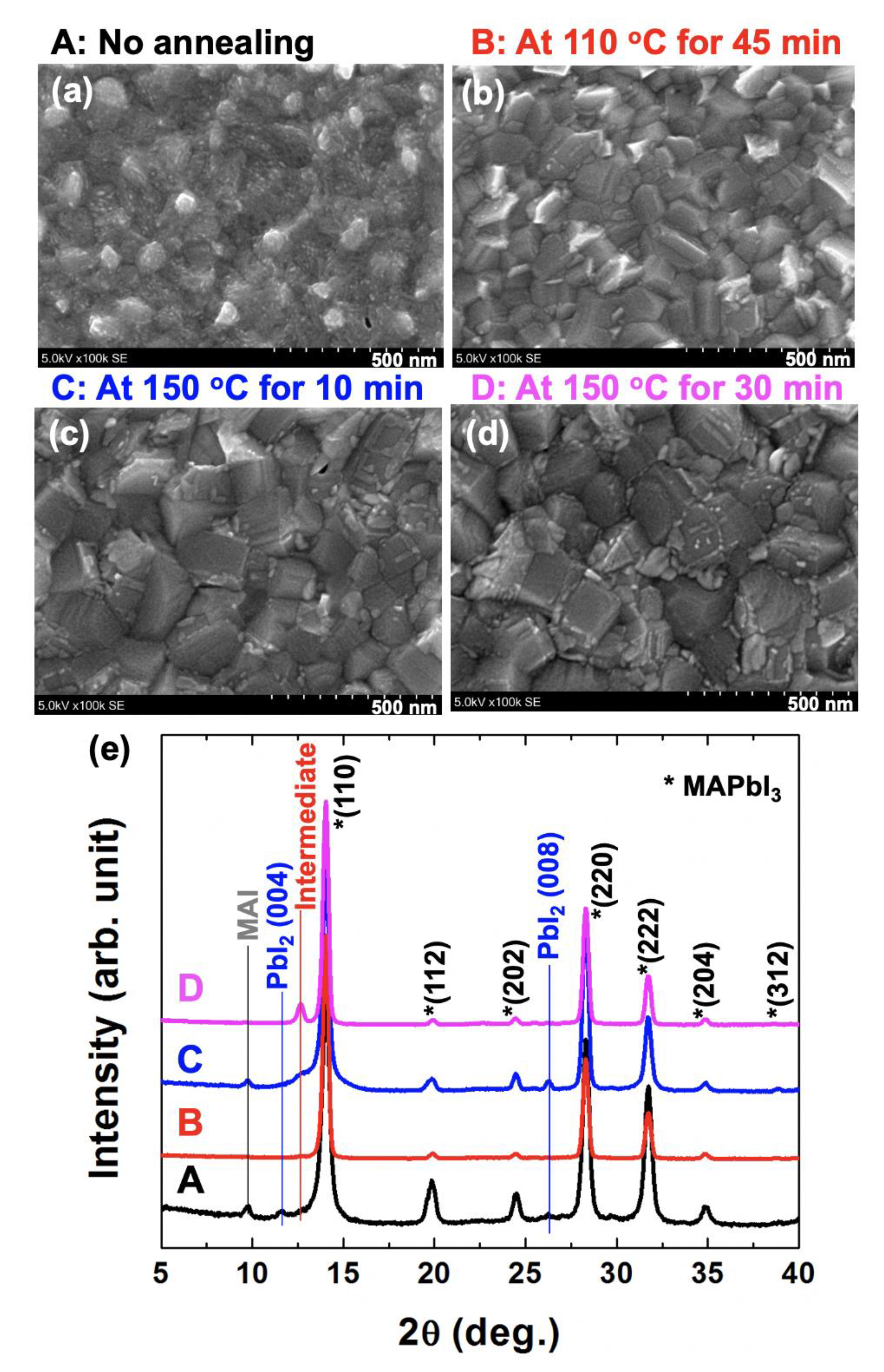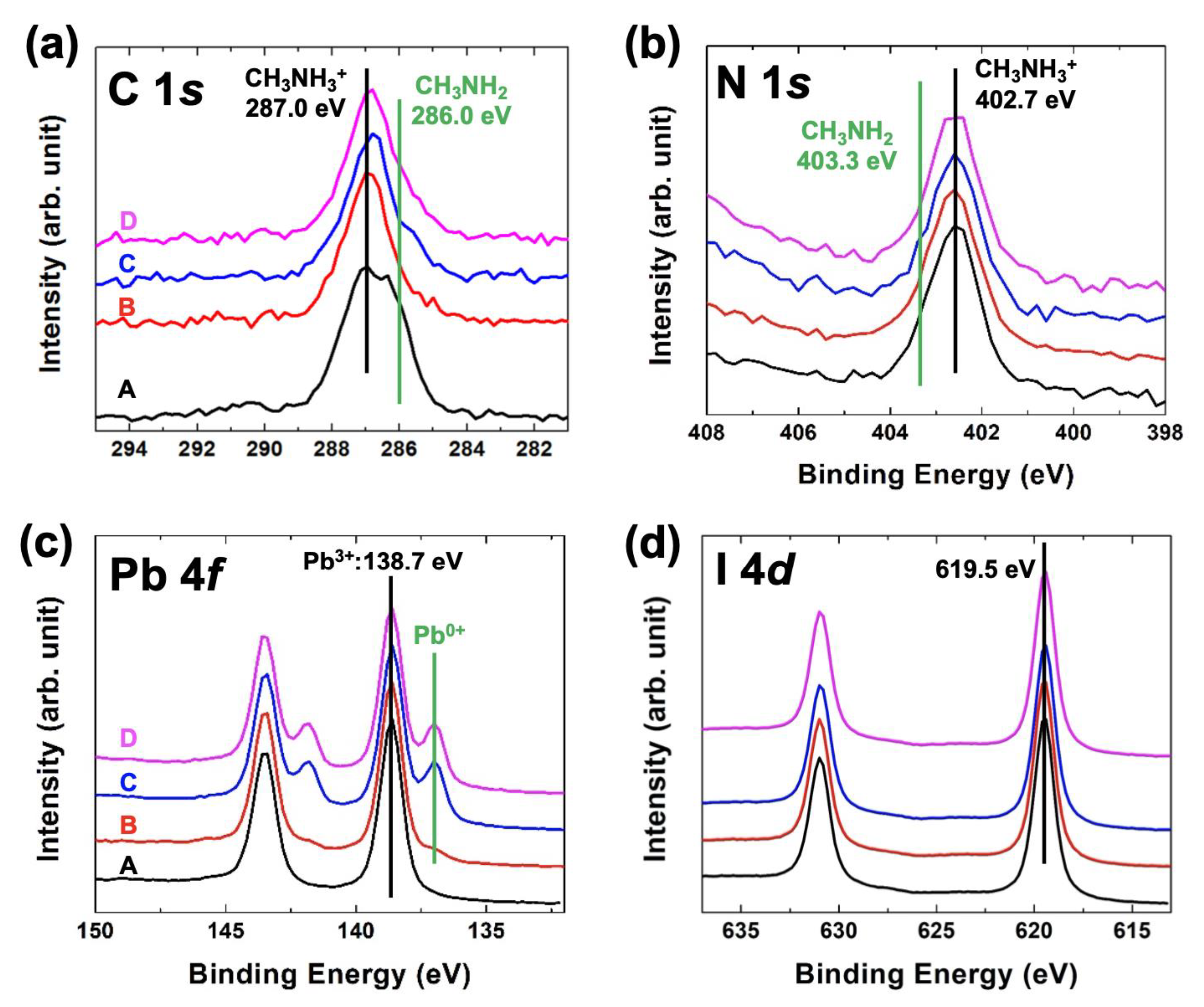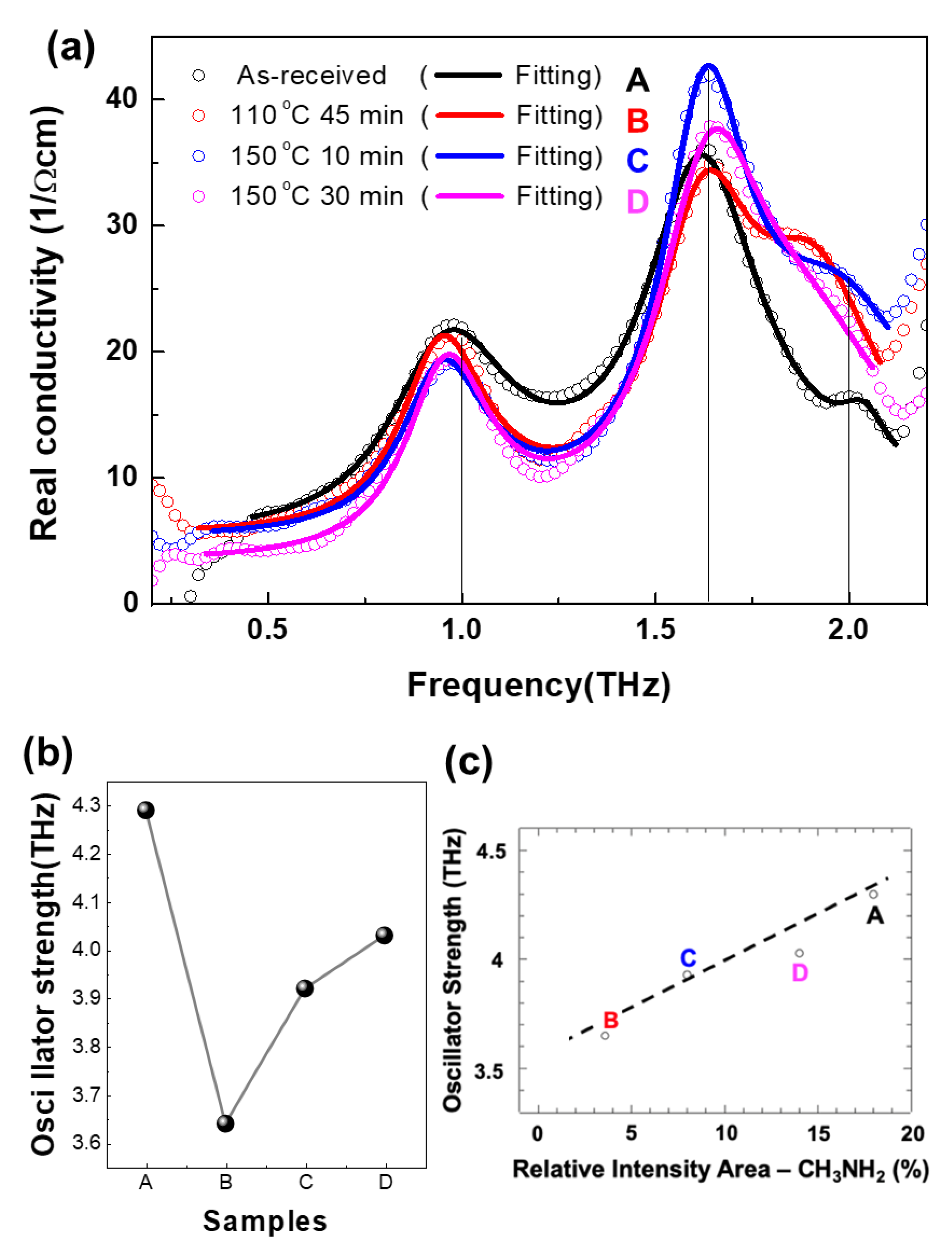Strong Linear Correlation between CH3NH2 Molecular Defect and THz-Wave Absorption in CH3NH3PbI3 Hybrid Perovskite Thin Film
Abstract
1. Introduction
2. Materials and Methods
3. Results and Discussion
4. Conclusions
Author Contributions
Acknowledgments
Conflicts of Interest
References
- Service, R.F. Turning up the light. Science 2013, 342, 794–797. [Google Scholar] [CrossRef] [PubMed]
- Park, N.G.; Miyasaka, T.; Grätzel, M. Organic-Inorganic Halide Perovskite Photovoltaics; Springer: Cham, Switzerland, 2016. [Google Scholar]
- Lin, H.; Zhou, C.; Tian, Y.; Siegrist, T.; Ma, B. Low-dimensional organometal halide perovskites. ACS Energy Lett. 2017, 3, 54–62. [Google Scholar] [CrossRef]
- Loi, M.A.; Hummelen, J.C. Hybrid solar cells: Perovskites under the Sun. Nat. Mater. 2013, 12, 1087–1089. [Google Scholar] [PubMed]
- Song, T.-B.; Chen, Q.; Zhou, H.; Jiang, C.; Wang, H.-H.; Yang, Y.; Liu, Y.; You, J.; Yang, Y. Perovskite solar cells: Film formation and properties. J. Mater. Chem. A 2015, 3, 9032–9050. [Google Scholar] [CrossRef]
- Senanayak, S.P.; Yang, B.; Thomas, T.H.; Giesbrecht, N.; Huang, W.; Gann, E.; Nair, B.; Goedel, K.; Guha, S.; Moya, X.; et al. Understanding charge transport in lead iodide perovskite thin-film field-effect transistors. Sci. Adv. 2017, 3, e1601935. [Google Scholar] [CrossRef] [PubMed]
- Stranks, S.D.; Snaith, H.J. Metal-halide perovskites for photovoltaic and light-emitting devices. Nat. Nanotechnol. 2015, 10, 391–402. [Google Scholar] [CrossRef]
- Perovskite Fever. Nat. Mater. 2014, 13, 837. [CrossRef][Green Version]
- Liu, P.; He, X.; Ren, J.; Liao, Q.; Yao, J.; Fu, H. Organic–inorganic hybrid perovskite nanowire laser arrays. ACS Nano 2017, 11, 5766–5773. [Google Scholar] [CrossRef]
- Frost, J.M.; Butler, K.T.; Brivio, F.; Hendon, C.H.; Van Schilfgaarde, M.; Walsh, A. Atomistic origins of high-performance in hybrid halide perovskite solar cells. Nano Lett. 2014, 14, 2584–2590. [Google Scholar] [CrossRef]
- Szostak, R.; Silva, J.C.; Turren-Cruz, S.-H.; Soares, M.M.; Freitas, R.O.; Hagfeldt, A.; Tolentino, H.C.N.; Nogueira, A.F. Nanoscale mapping of chemical composition in organic-inorganic hybrid perovskite films. Sci. Adv. 2019, 5, eaaw6619. [Google Scholar] [CrossRef]
- Lee, Y.M.; Yun, J.-H.; Matsuyama, A.; Kobori, S.; Maeng, I.; Lyu, M.; Wang, S.; Wang, L.; Jung, M.; Nakamura, M. Significant THz-wave absorption property in mixed δ- and α-FAPbI3 hybrid perovskite flexible thin film formed by sequential vacuum evaporation. Appl. Phys. Express 2019, 12, 051003. [Google Scholar] [CrossRef]
- Maeng, I.; Lee, Y.M.; Park, J.; Raga, S.R.; Kang, C.; Kee, C.-S.; Yu, B.D.; Hong, S.; Ono, L.K.; Qi, Y.; et al. Significant THz absorption in CH3NH2 molecular defect-incorporated organic-inorganic hybrid perovskite thin film. Sci. Rep. 2019, 9, 5811. [Google Scholar] [CrossRef] [PubMed]
- Lee, Y.M.; Maeng, I.; Park, J.; Song, M.; Yun, J.-H.; Jung, M.; Nakamura, M. Comprehensive understanding and controlling the defect structures: An effective approach for organic-inorganic hybrid perovskite-based solar-cell application. Front. Energy Res. 2018, 6, 6. [Google Scholar] [CrossRef]
- Zhao, G.; Schouten, R.N.; Van Der Valk, N.; Wenckebach, W.T.; Planken, P.C.M. Design and performance of a THz emission and detection setup based on a semi-insulating GaAs emitter. Rev. Sci. Instruments 2002, 73, 1715–1719. [Google Scholar] [CrossRef]
- Nagai, M.; Tanaka, K.; Ohtake, H.; Bessho, T.; Sugiura, T.; Hirosumi, T.; Yoshida, M. Generation and detection of terahertz radiation by electro-optical process in GaAs using 1.56 μm fiber laser pulses. Appl. Phys. Lett. 2004, 85, 3974–3976. [Google Scholar] [CrossRef]
- Ono, L.K.; Qi, Y. Surface and interface aspects of organometal halide perovskite materials and solar cells. J. Phys. Chem. Lett. 2016, 7, 4764–4794. [Google Scholar] [CrossRef] [PubMed]
- Zhao, X.; Park, N.-G. Stability issues on perovskite solar cells. Photon 2015, 2, 1139–1151. [Google Scholar] [CrossRef]
- Berhe, T.A.; Su, W.-N.; Chen, C.-H.; Pan, C.-J.; Cheng, J.-H.; Chen, H.-M.; Tsai, M.-C.; Chen, L.-Y.; Dubale, A.A.; Hwang, B.J. Organometal halide perovskite solar cells: Degradation and stability. Energy Environ. Sci. 2016, 9, 323–356. [Google Scholar] [CrossRef]
- Jung, M.; Raga, S.R.; Qi, Y. Properties and solar cell applications of Pb-free perovskite films formed by vapor deposition. RSC Adv. 2016, 6, 2819–2825. [Google Scholar] [CrossRef]
- Jung, M.; Kobori, S.; Matsuyama, A.; Maeng, I.; Lee, Y.M.; Kojima, H.; Benten, H.; Nakamura, M. Formation of CH3NH2-incorporated intermediate state in CH3NH3PbI3 hybrid perovskite thin film formed by sequential vacuum evaporation. Appl. Phys. Express 2018, 12, 015501. [Google Scholar] [CrossRef]
- Wagner, C.D.; Riggs, W.M.; Davis, L.E.; Moulder, J.F.; Muilenberg, G.E. Handbook of X-ray Photoelectron Spectroscopy: A Reference Book of Standard Data for Use in X-Ray Photoelectron Spectroscopy; Chastain, J., Ed.; Physical Electronics Division, Perkin-Elmer Corporation: Eden Praire, MN, USA, 1995. [Google Scholar]
- Tinkham, M. Energy gap interpretation of experiments on infrared transmission through superconducting films. Phys. Rev. 1956, 104, 845–846. [Google Scholar] [CrossRef]
- Doniach, S.; Sunjic, M. Many-electron singularity in X-ray photoemission and X-ray line spectra from metals. J. Phys. C: Solid State Phys. 1970, 3, 285–291. [Google Scholar] [CrossRef]
- Shirley, D.A. High-resolution X-ray photoemission spectrum of the valence bands of gold. Phys. Rev. B 1972, 5, 4709–4714. [Google Scholar] [CrossRef]
- La-O-Vorakiat, C.; Xia, H.; Kadro, J.; Salim, T.; Zhao, D.; Ahmed, T.; Lam, Y.M.; Zhu, J.X.; Marcus, R.A.; Michel-Beyerle, M.E.; et al. Phonon mode transformation across the orthohombic-tetragonal phase transition in a lead iodide perovskite {CH}3NH3PBI3: A terahertz time-domain spectroscopy approach. J. Phys. Chem. Lett. 2016, 7, 1–6. [Google Scholar] [CrossRef]





| Sample | ω0/2π [THz] | Ω/2π [THz] | γ/2π [THz] |
|---|---|---|---|
| A | 0.97 | 3.19 | 0.389 |
| 1.62 | 4.29 | 0.37 | |
| 2.03 | 1.14 | 0.15 | |
| B | 0.95 | 2.66 | 0.272 |
| 1.62 | 3.64 | 0.319 | |
| 1.91 | 3.36 | 0.395 | |
| C | 0.95 | 2.51 | 0.276 |
| 1.63 | 3.92 | 0.274 | |
| 1.98 | 3.88 | 0.549 | |
| D | 0.96 | 2.66 | 0.269 |
| 1.64 | 4.03 | 0.343 | |
| 1.9 | 3.66 | 0.59 |
© 2020 by the authors. Licensee MDPI, Basel, Switzerland. This article is an open access article distributed under the terms and conditions of the Creative Commons Attribution (CC BY) license (http://creativecommons.org/licenses/by/4.0/).
Share and Cite
Maeng, I.; Matsuyama, A.; Yun, J.-H.; Wang, S.; Kang, C.; Kee, C.-S.; Nakamura, M.; Jung, M.-C. Strong Linear Correlation between CH3NH2 Molecular Defect and THz-Wave Absorption in CH3NH3PbI3 Hybrid Perovskite Thin Film. Nanomaterials 2020, 10, 721. https://doi.org/10.3390/nano10040721
Maeng I, Matsuyama A, Yun J-H, Wang S, Kang C, Kee C-S, Nakamura M, Jung M-C. Strong Linear Correlation between CH3NH2 Molecular Defect and THz-Wave Absorption in CH3NH3PbI3 Hybrid Perovskite Thin Film. Nanomaterials. 2020; 10(4):721. https://doi.org/10.3390/nano10040721
Chicago/Turabian StyleMaeng, Inhee, Asuka Matsuyama, Jung-Ho Yun, Shenghao Wang, Chul Kang, Chul-Sik Kee, Masakazu Nakamura, and Min-Cherl Jung. 2020. "Strong Linear Correlation between CH3NH2 Molecular Defect and THz-Wave Absorption in CH3NH3PbI3 Hybrid Perovskite Thin Film" Nanomaterials 10, no. 4: 721. https://doi.org/10.3390/nano10040721
APA StyleMaeng, I., Matsuyama, A., Yun, J.-H., Wang, S., Kang, C., Kee, C.-S., Nakamura, M., & Jung, M.-C. (2020). Strong Linear Correlation between CH3NH2 Molecular Defect and THz-Wave Absorption in CH3NH3PbI3 Hybrid Perovskite Thin Film. Nanomaterials, 10(4), 721. https://doi.org/10.3390/nano10040721







